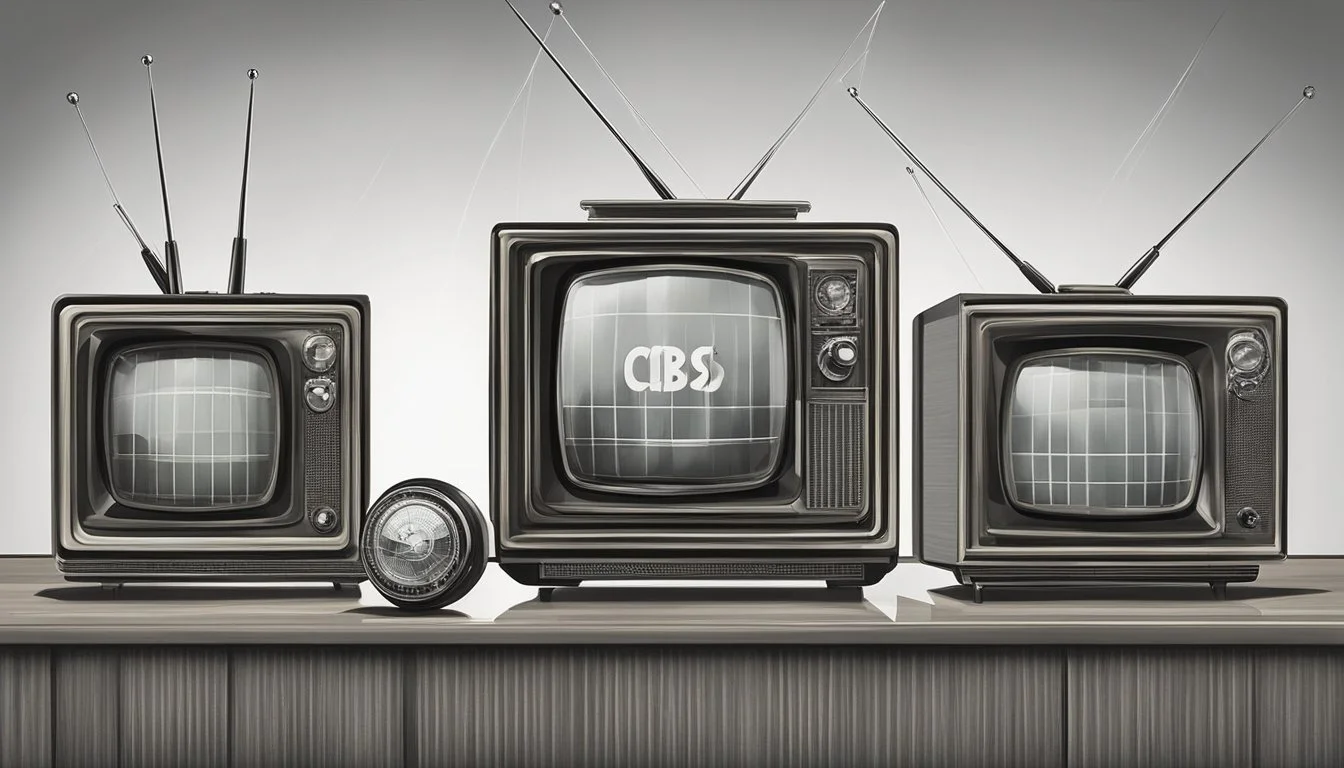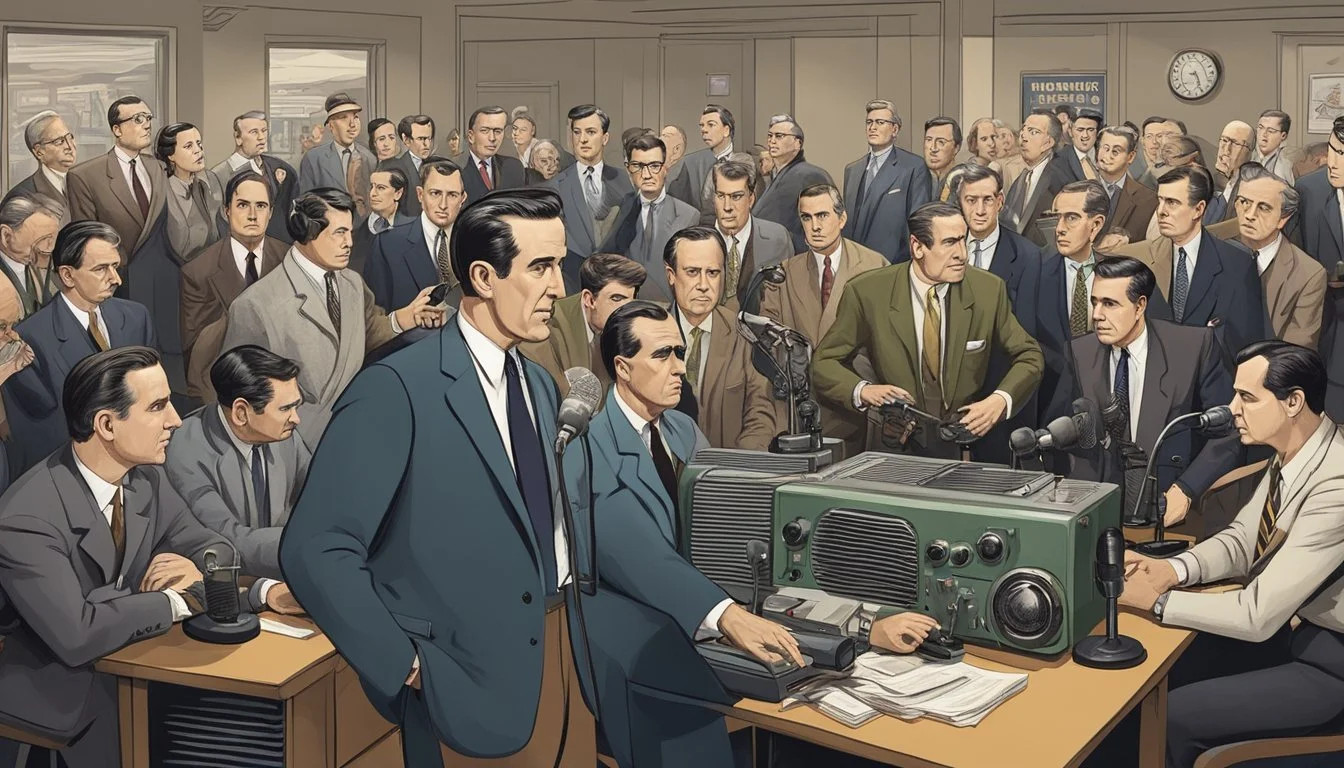Murrow vs. McCarthy: The Real Broadcast Battle
Televised Showdown That Shaped American Politics
The 1950s witnessed a pivotal clash between two influential figures that would shape American media and politics for years to come. Edward R. Murrow, a respected CBS News journalist, confronted Senator Joseph McCarthy's anti-communist campaign through the power of television. Murrow's groundbreaking broadcast on March 9, 1954, exposed McCarthy's tactics and marked a turning point in the senator's career.
This on-air battle highlighted the growing influence of television news in shaping public opinion. Murrow used his "See It Now" program to meticulously dissect McCarthy's accusations and methods, presenting viewers with a critical analysis of the senator's actions. The broadcast demonstrated the potential of television journalism to challenge political figures and spark national conversations.
The confrontation between Murrow and McCarthy represented more than just a personal feud. It underscored the tension between freedom of the press and political power during the Cold War era. Murrow's willingness to challenge McCarthy on air showcased the role of responsible journalism in a democracy and set a precedent for future investigative reporting.
The Rise of Television and CBS
Television emerged as a powerful new medium in the 1950s, transforming the media landscape. CBS played a pivotal role in this shift, with Edward R. Murrow at the forefront of broadcast journalism.
Edward R. Murrow: From Radio to TV
Edward R. Murrow gained fame as a radio correspondent during World War II. His transition to television was marked by innovative programming that set new standards for broadcast journalism.
Murrow's "See It Now" debuted in 1951, bringing hard-hitting news to television screens across America. The program tackled controversial topics and featured in-depth reporting.
Murrow's distinctive style and authoritative voice translated well to the visual medium. His presence on screen lent credibility to the fledgling medium of television news.
CBS's Role in Shaping Broadcast Journalism
CBS invested heavily in news programming during the 1950s. The network built a team of talented journalists and producers who pioneered new formats for television news.
CBS News developed signature programs like "CBS Reports" and "Face the Nation." These shows set high standards for investigative reporting and political analysis on television.
The network's commitment to news programming helped establish television as a serious source of information. CBS News became known for its integrity and journalistic excellence.
The Power of Television in Public Opinion
Television's visual nature made it uniquely suited to shape public opinion. Viewers could now see events unfold in their living rooms, creating a more immediate and emotional connection to the news.
Political figures quickly recognized television's influence. The medium's ability to reach millions of homes simultaneously made it a powerful tool for communication and persuasion.
TV news coverage of major events, from political speeches to social movements, had a profound impact on public discourse. The visual element of television added a new dimension to how people understood and engaged with current events.
A Nation Under Threat: Cold War Context
The Cold War era was marked by intense ideological conflict and global power struggles. Fear and suspicion permeated American society as the threat of communism loomed large.
Communism vs. Democracy: Global Tensions
The United States and Soviet Union emerged as superpowers after World War II, each championing opposing ideologies. Democracy and capitalism clashed with communism and state control.
This rivalry sparked proxy wars, arms races, and covert operations worldwide. The Berlin Blockade of 1948-1949 and the Korean War (1950-1953) heightened tensions.
Nuclear weapons development raised the stakes, with both sides building massive arsenals. The threat of mutually assured destruction became a grim reality.
McCarthyism and Domestic Fear
Senator Joseph McCarthy stoked anti-communist sentiment in the early 1950s. He claimed communist agents had infiltrated the U.S. government and other institutions.
McCarthy's accusations led to widespread paranoia and witch hunts. Many Americans faced scrutiny, job loss, and social ostracism based on suspicion alone.
The House Un-American Activities Committee investigated alleged communist sympathizers. Hollywood saw blacklists of suspected communists in the entertainment industry.
The Role of Allies and Enemies Abroad
The U.S. sought to contain communism globally through alliances and interventions. NATO formed in 1949 to unite Western powers against Soviet expansion.
In Eastern Europe, the USSR established satellite states under its control. The Iron Curtain divided the continent ideologically and physically.
The Marshall Plan provided economic aid to rebuild war-torn Europe. This strategy aimed to prevent the spread of communism by stabilizing allied nations.
China's communist revolution in 1949 shifted power dynamics in Asia. The U.S. supported anti-communist forces in various regions to maintain its sphere of influence.
Profiles in Contention
The clash between Edward R. Murrow and Joseph McCarthy represented a pivotal moment in American politics and journalism. Their confrontation highlighted the tension between national security concerns and civil liberties during the Cold War era.
Senator Joseph McCarthy: Biography and Ideology
Joseph McCarthy, a Republican senator from Wisconsin, rose to prominence in the early 1950s. Born in 1908, he served in the U.S. Marine Corps during World War II before entering politics. McCarthy gained national attention in 1950 with his claims of communist infiltration in the U.S. government.
His aggressive anti-communist stance resonated with many Americans fearful of Soviet influence. McCarthy's tactics included making accusations without substantial evidence and using public hearings to intimidate suspected communists.
The term "McCarthyism" emerged to describe the practice of making unsubstantiated allegations and using fear to suppress opposition. McCarthy's influence peaked in 1953-1954, but his methods eventually led to his downfall.
Edward R. Murrow: Journalism's Champion
Edward R. Murrow, born in 1908, became one of America's most respected broadcast journalists. He gained fame for his radio reports during World War II, bringing the realities of war to American listeners.
Murrow transitioned to television in the 1950s, hosting the news program "See It Now" on CBS. He was known for his integrity, eloquence, and commitment to responsible journalism.
In March 1954, Murrow used his platform to challenge McCarthy's tactics. His broadcast exposed McCarthy's methods and questioned the senator's credibility. Murrow's famous sign-off, "Good night, and good luck," became a rallying cry for journalistic courage.
Support and Dissent in the Political Arena
McCarthy's anti-communist campaign initially garnered significant support from fellow Republicans and some Democrats. Many politicians were hesitant to challenge him for fear of being labeled communist sympathizers.
However, as McCarthy's methods became more extreme, dissent grew. Figures like Republican Senator Margaret Chase Smith spoke out against his tactics. President Eisenhower, while publicly cautious, worked behind the scenes to undermine McCarthy's influence.
Murrow's broadcast emboldened more voices to challenge McCarthy. The Army-McCarthy hearings in 1954 further eroded the senator's credibility. In December 1954, the Senate voted to condemn McCarthy, effectively ending his political power.
See It Now: The Broadcast Battle
Edward R. Murrow's "See It Now" program became a pivotal moment in television history, confronting Senator Joseph McCarthy's anti-communist crusade. The broadcast challenged McCarthy's tactics and influenced public opinion through innovative journalism.
The Making of 'See It Now'
"See It Now" debuted on CBS in 1951 as a groundbreaking documentary series. Edward R. Murrow and producer Fred Friendly created the show to tackle important issues of the day. The program utilized innovative techniques, including the use of multiple cameras and live remote broadcasts.
Murrow's journalistic integrity and courage set the tone for the series. He insisted on addressing controversial topics, even when they risked alienating sponsors or network executives.
The show's format allowed for in-depth exploration of complex subjects, a rarity in early television. This approach laid the groundwork for the confrontation with Senator McCarthy.
Confrontation on Air: Murrow vs. McCarthy
On March 9, 1954, "See It Now" aired its most famous episode: "A Report on Senator Joseph R. McCarthy". Murrow used McCarthy's own words and footage to expose inconsistencies and questionable tactics in the senator's anti-communist campaign.
The broadcast methodically dissected McCarthy's claims and methods. Murrow presented evidence of McCarthy's bullying tactics and disregard for due process.
In his closing remarks, Murrow delivered his famous line: "We must not confuse dissent with disloyalty." This statement encapsulated the show's critique of McCarthy's approach to rooting out supposed communists.
McCarthy was offered rebuttal time, which he used on April 6, 1954. His response, however, largely consisted of personal attacks on Murrow rather than addressing the substance of the original broadcast.
The Impact of 'See It Now' on American Society
The "See It Now" episode on McCarthy marked a turning point in public perception of the senator. It demonstrated television's power to shape political discourse and public opinion.
Murrow's broadcast emboldened other journalists to challenge McCarthy's tactics. This collective scrutiny contributed to the senator's eventual censure by the U.S. Senate in December 1954.
The program set a new standard for broadcast journalism. It showed that television could be a platform for serious, in-depth reporting on complex issues.
"See It Now" inspired future generations of journalists and filmmakers. The 2005 film "Good Night, and Good Luck" portrayed this historic broadcast, introducing it to new audiences.
The episode's impact extended beyond McCarthy. It established the importance of journalistic courage in the face of political pressure, a principle that remains relevant in modern media.
The Aftermath and Legacy
The confrontation between Murrow and McCarthy had far-reaching consequences for both men and American society. It reshaped public perception of political accusations and journalism's role in democracy.
Consequences for McCarthy and His Accusations
Senator Joseph McCarthy's influence waned rapidly after Murrow's broadcasts. The Senate censured McCarthy in December 1954, condemning his behavior as contrary to senatorial traditions. Public opinion turned against the senator's tactics, and his political career never recovered.
McCarthy's fall from grace marked the end of the Red Scare era. His name became synonymous with baseless accusations and political witch hunts. The term "McCarthyism" entered the lexicon, describing the practice of making unfounded allegations of subversion or treason.
The senator's downfall reinforced the importance of due process and evidence in political discourse. It also highlighted the dangers of unchecked power and the value of journalistic scrutiny in a democratic society.
Reflections on Murrow's Influence in Journalism
Edward R. Murrow's confrontation with McCarthy cemented his status as a journalistic icon. His courage in challenging a powerful political figure set a new standard for broadcast journalism.
Murrow's approach emphasized thorough research, fact-checking, and balanced reporting. His work inspired a generation of journalists to pursue investigative reporting and hold those in power accountable.
The clash demonstrated the potential of television as a medium for serious journalism. It showed that TV could be more than just entertainment - it could inform, educate, and influence public opinion on crucial issues.
Murrow's famous sign-off, "Good night, and good luck," became a rallying cry for journalists committed to truth and integrity in reporting.
Historical Interpretation and Cultural Documentation
The Murrow-McCarthy confrontation has become a pivotal moment in American cultural and political history. It's been the subject of numerous books, documentaries, and films, including the 2005 movie "Good Night, and Good Luck."
Historians view this event as a turning point in the Cold War era, marking the beginning of the end for McCarthy's anti-communist crusade. It exemplifies the crucial role of a free press in safeguarding democratic values and challenging abuses of power.
The broadcasts serve as important historical documents, providing insight into the climate of fear and suspicion that characterized 1950s America. They continue to be studied in journalism schools and political science courses as examples of media's potential to shape public discourse.



